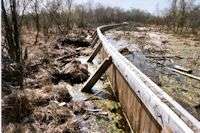Palisade timber dam lining a hydrological compartment, where the water table was raised. Photo credit: Wilco Verberk.
(PhysOrg.com) -- Traditional methods of restoring peat bogs may be doing more harm than good to the diversity of plant and animal life, research has found.
Peat bogs are important as they provide a carbon sink and so aid the capture of CO2. Many bogs in north-western Europe have become dried out through overuse and extraction of peat. The most common way to restore and conserve these vital eco-systems has been to build a dam to raise the water level on a large scale.
However, research by University of Plymouth scientist Dr Wilco Verberk and others has found that this has an adverse effect on animal life. Water levels rise rapidly causing a loss of variation in site conditions and the decline of characteristic species. This can have serious long term effects as various species of insects may be lost.
Dr Verberk's team sampled a large number of ponds over eight years and captured more than 300 different species of invertebrates. They found that by increasing the amount of groundwater gradually, the biodiversity of the peat bog could be preserved.
"Increasing groundwater supply through measures such as filling in drainage ditches and reversing incision by streams is a better restoration strategy," said Dr Verberk. "We found that where groundwater increased, the number of rare species of water beetles and caddisfly increased. In addition, growth of peat moss can be also stimulated in this way, thus providing a promising alternative restoration strategy".
The research was funded by the Dutch Ministry of Agriculture, Nature and Food Quality and is due to be published in the next edition of the influential journal, Basic and Applied Ecology.
More information: Loss of environmental heterogeneity and aquatic macroinvertebrate diversity following large-scale restoration management. Wilco C.E.P. Verberk, Rob S.E.W.Leuven, Gert-Jan A. van Duinen & Hans Esselink. Basic and Applied Ecology (2010): doi:10.1016/j.baae.2010.04.001
Provided by University of Plymouth


















